[Editor’s note: the post below appears today at The Huffington Post.]
By Jason Apuzzo. It’s by far the biggest, best and most surprising entertainment news of 2012, yet still no one knows quite what to make of it: starting in 2015 we’re getting a new Star Wars trilogy, beginning with Episode VII, supervised by George Lucas and produced by Disney.
As Darth Vader might say, there’s “a tremor in the Force.” The question is: what will this new Star Wars look like, now that we don’t have Emperor Palpatine to kick around any more?
There’s certainly been nothing like this news in Hollywood in years, with rumors swirling around about the new Star Wars films almost on a daily basis. What will the new storyline be? Who will direct the films? Will Mark Hamill, Carrie Fisher or Harrison Ford make a cameo? Did Boba Fett survive the Sarlacc Pit?
And will SPECTRE or the Miami Heat be the new villains?
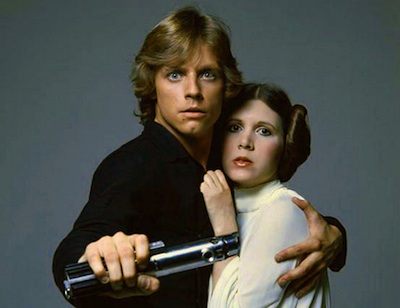
It seems incredible that overnight Star Wars has managed to reinvent itself – again – and become the biggest, most talked-about sci-fi franchise around. (Imagine what James Cameron must be thinking right now.) The question on everyone’s mind, though, is what exactly a new Star Wars trilogy will look like with limited involvement from George Lucas, the original cast having hit retirement age, many crucial characters gone, and having to pick up where 1983’s Return of the Jedi left off – i.e., with Ewoks playing victorious drum solos on Stormtrooper helmets.
In other words, what is the ‘essence’ of a Star Wars film now that the series can’t lean on standbys like Yoda or Obi-Wan Kenobi or exploding Death Stars anymore?
For clues to this mystery, it’s best to go back to the 1970s, the fabulous era – at least, for science fiction fans – when Star Wars was born.
Although the 1950s are justifiably regarded as science fiction’s Golden Age, the era of the 1970s easily rates a close second. It was the period when science fiction finally replaced the Western as the great American movie genre.
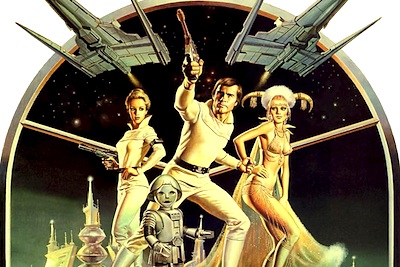
To be fair, what we’re calling ‘the ’70s’ here probably began around 1968 with the release of 2001: A Space Odyssey and Planet of the Apes, and didn’t end till around 1984, with the release of The Terminator. So maybe we should call this sci-fi’s ‘modern’ era – or simply ‘the Star Wars era.’ Science fiction had a distinctive flavor during this period – it was darker, more realistic, and also more emotional – and Star Wars set the tone for the time.
It was also during this era that science fiction became more popular than ever – more popular even than comic book movies are today – dominating both the box office and prime time television.
Of the top 15 highest grossing movies of all time adjusted for inflation, four are sci-fi films from this period: the original Star Wars trilogy, plus Steven Spielberg’s E.T. A host of other films from this time – Alien, Blade Runner, Close Encounters of the Third Kind, Star Trek II: The Wrath of Khan, just to name a few – are similarly regarded as classics. Plus, television series like The Six Million Dollar Man (and its spin-off, The Bionic Woman), Battlestar Galactica and Buck Rogers in the 25th Century were huge hits – with the Galactica franchise still around with us today.
So how did they do it back then? What made sci-fi of this period so wildly popular?
The key thing to understand about ’70s or Star Wars-era sci-fi was how it revised and updated a genre that had gotten old and slightly creaky (think Voyage to the Bottom of the Sea). It did so in three major ways:
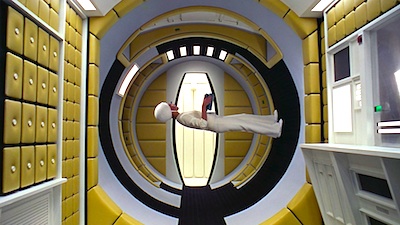
1) Science fiction became more realistic.
The big leap forward in sci-fi ‘realism’ came in 1968 with Stanley Kubrick’s 2001: A Space Odyssey, which Kubrick made after consulting with scientists and engineers at NASA and MIT, and after devising new visual effects techniques like front projection. After 2001, which played out like a Cinerama documentary shot in space, sci-fi films couldn’t afford to look anymore like they were shot in your parents’ garage (even if they were).
George Lucas and his geniuses at Industrial Light & Magic raised the bar on sci-fi realism even higher with Star Wars in 1977 – while adding a new twist: a ‘used universe’ design style that gave everything a gritty, dented, lived-in feel. It was this gnarly, textured aesthetic that later influenced Alien, Blade Runner, Outland and a lot of other great sci-fi of the era – and became the key factor in making people believe that the sci-fi they were seeing was ‘real.’
Before the original Star Wars, watching sci-fi films sometimes felt like visiting Neiman Marcus – all shiny surfaces, supermodels and expensive clothing. That’s basically what you got in fun but conventional sci-fi fare like Rollerball (1975) or Logan’s Run (1976).
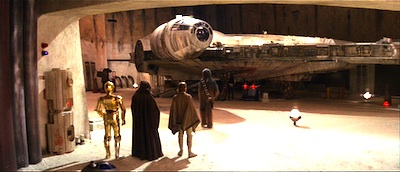
Star Wars changed all this, as Lucas dropped his characters into garbage compactors and grimy cantinas, or had them hauled around in Jawa junk caravans and broken-down cargo freighters – like the wonderfully clunky Millennium Falcon. It all brought sci-fi down to Earth, grounded it in a more believable reality, and made the genre more accessible to average audiences.
So after the clean, polished, Art Deco look of the prequel trilogy, Star Wars should go back to looking like it did in 1977: a used car lot in outer space. Robots and ships should go back to looking bulky, stiff and dysfunctional – like something out of your local repair shop, not an Apple Genius Bar. It would immediately throw everyone back into the world we last saw in 1983.
As part of this, whoever directs the new film should avoid having every setting be digital. Spend some money and build real sets! Don’t worry, Disney can afford it.
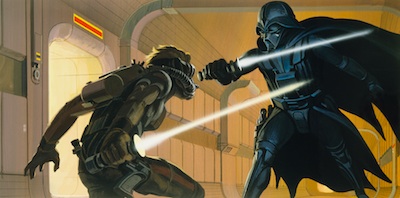
2) Science fiction became more dystopian.
This is an important point: the original Star Wars has often been attacked for introducing a cheery, uncritical optimism to the otherwise ‘edgier’ Hollywood cinema of the 1970s.
Except that it didn’t quite go down that way.
Like so much sci-fi of the 1970s, the original Star Wars was basically dystopian – depicting a galaxy ruled by an inhumane Empire, a military dictatorship presided over by a genocidal cyborg (Darth Vader). Over the course of the film, a planet gets destroyed (Alderaan), the hero’s family and kindly mentor (Ben Kenobi) are killed off, a princess is subjected to an invasive mind probe (by her own father, as it later turns out), and the heroes are rewarded in a ceremony that looks suspiciously like something out of Triumph of the Will.
I guess back in the ’70s that seemed cheerful.
The truth is, Star Wars-era science fiction was full of tyrants, nasty aliens and menacing cyborgs; think of Khan from Star Trek II, or the creature from Alien, or the ‘replicant’ Roy Batty from Blade Runner, or the HAL 9000 from 2001. These figures captured the anxiety of the times – as America’s economy went in the tank, international tensions dragged on, and technology made unwelcome encroachments on people’s lives.
By the way, is any of this sounding familiar?
Now would be a good time for Star Wars to go back to its roots as a parable of the struggle for freedom in a depressed world. People are low right now – much like they were in the ’70s – and a good new Star Wars trilogy might pick everybody up. Part of why Star Wars felt so uplifting back in the ’70s was that the film acknowledged we were living in tough times – but also that we could pull out of them with a little heroism and good humor.
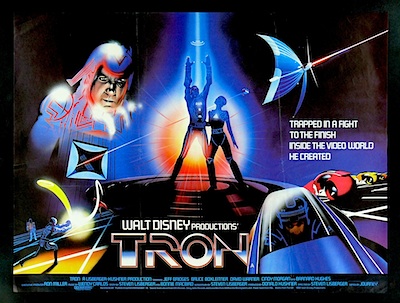
One other point: some people worry that Disney would never let Star Wars go back to being a ‘darker’ franchise (a la The Empire Strikes Back). Actually, Disney produced two gems of dystopian sci-fi back in the Star Wars era: The Black Hole (1979) and Tron (1982). Plus, many of the great Disney classics – one thinks of Snow White, Fantasia, or 20,000 Leagues Under the Sea – are essentially dark fairy tales, very much in keeping with the original Star Wars vision. Certainly the recent Tron: Legacy (2010) showed that Disney still has the taste for this kind of sci-fi material.
So assuming Bob Iger doesn’t want to jam Hannah Montana into a Star Wars film, the marriage between Disney and the Star Wars franchise should be a good one – and may be what the series needed.
3) Science fiction became more emotional.
Ask anyone who was around back in 1977 and they’ll tell you: watching Star Wars in a packed theater was an emotional experience, a major event. You waited in line for hours just to get in, watched the opening scroll and the huge Imperial Star Destroyer roar over your head in Dolby stereo, and by the time Han Solo flipped the Millennium Falcon into hyperdrive people just went wild.
And when Luke finally blew up the Death Star? The house came down.
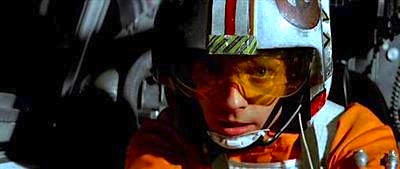
Watching Star Wars in a theater was simply the pop-culture experience of the 1970s. Whatever the Beatles were to the Boomer generation, Star Wars was to Generation X. People came out of theaters feeling that their lives had changed.
But the funny thing was, a lot of sci-fi during this period was emotional. Grown men cried watching Spock sacrifice himself in Star Trek II; and everybody cried during E.T. And to this day, the most frightening film I’ve ever seen in a theater was still the original Alien; the emotion that film provoked in me was sheer terror.
Sci-fi somehow struck emotional chords back in the Star Wars era that it’s simply not hitting today. (Although I admit to having a soft spot for Bumblebee in the Transformers movies; maybe that’s because he reminds me of R2-D2). My hope is that the new Star Wars films are crafted with human emotions in mind, rather than just sci-fi spectacle.
We have enough visual pyrotechnics today, don’t we? What we don’t have are characters anybody cares about.
Personally, I’d love to see Mark Hamill, Carrie Fisher and Harrison Ford make cameos in the new film – even if just for a minute. It would be a gas, the ultimate reunion, like Led Zeppelin getting back together. And it would be emotional. I imagine Han Solo holding down a corner with Chewie in the Mos Eisley cantina, throwing back a few drinks, telling stories about how Leia finally dumped him – then maybe blasting a bounty hunter or two.
Only this time, Han shoots first.
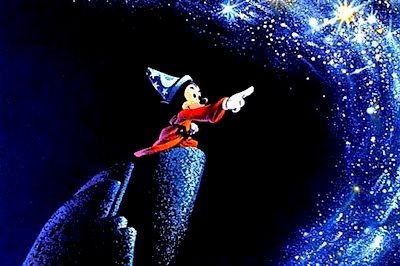
So in the grand scheme of things, what does it mean that Disney now owns Star Wars? Disney’s certainly been a good fit for Pixar and Marvel, so Lucasfilm has likely found the right home. (Actually, could Disney buy the Oakland Raiders while they’re at it?)
What it means is that we’re not only going to get a new trilogy, but probably a live action Star Wars TV series for ABC, and also spin-off movies for certain characters – just like with Marvel. Boba Fett may finally get his own films (he should), or even Expanded Universe figures like Prince Xizor or Darth Bane – which would be fun.
Who knows? Your children may someday end up watching a Salacious Crumb series, or a brand new show on the Real Housewives of Tatooine.
By then I’ll probably have checked out of Star Wars, thinking that I’ve had my fill. Of course, that’s what I thought back in 1983 …
[Special note: fans of ’70s-era science fiction should check out Christopher Mills’ excellent Space: 1970 website.]
Posted on December 14th, 2012 at 10:30am.
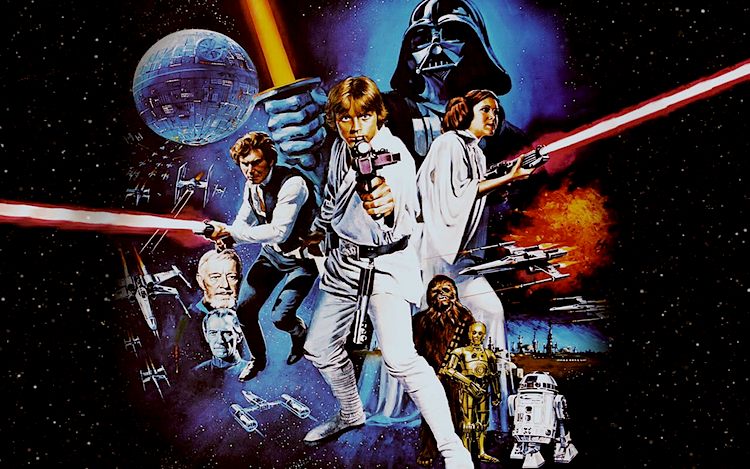
Nice piece — it jibes with a lot of my memories of watching those movies growing up, especially the energy of seeing “Star Wars” in a theater. And thanks for the Mills link; looks very interesting. But I will quibble twice:
1) “The Black Hole” was not dark, it was drek. The Slim Pickens-voiced half-junked robot alone is reason to ignore it forevermore.
2) Han *always* shot first.